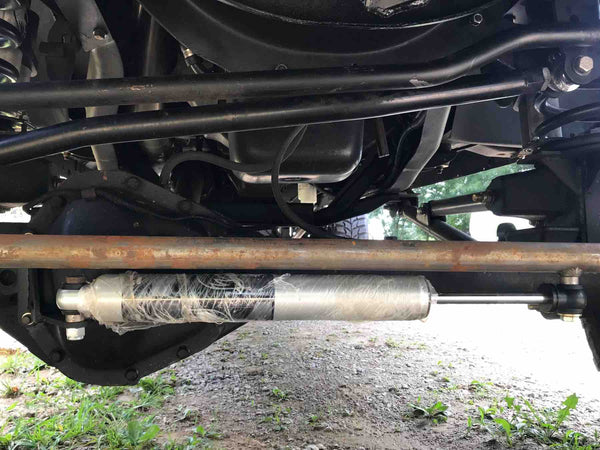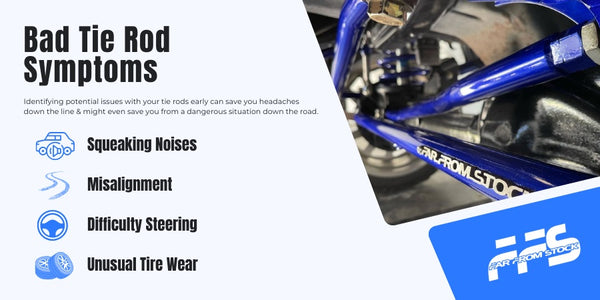
What Do Tie Rods Do?
It's crucial to understand the roles of the various components that make up your vehicle. One such part, the tie rod, may not be a term as commonly heard as the engine or tires, but as any car enthusiast knows, they play an invaluable role in keeping your ride smooth and safe.
So, what do tie rods do? We will explore this in depth, but before diving in, let's briefly clarify what a tie rod is. Often dismissed as a mere rod connecting two wheels, its true purpose encompasses much more. In simple terms, tie rods are a critical part of your vehicle's steering mechanism that translates the movement of the steering wheel into the wheels of your vehicle. In other words, they are the link between your car's steering system and its front wheels. No tie rod – no steering. Kinda a big deal, right?
Knowing what your vehicle's tie rods do and how they interact with other components is key to spotting potential issues before they evolve into costly problems.
Understanding Tie Rods
As we've established, the steering system of a vehicle is dependent on many different parts — including tie rods. So, let’s dive deeper into tie rods and their much-needed efficiencies.

What Makes Up a Tie Rod?
A tie rod comprises two main parts: the inner tie rod and the outer tie rod. The inner tie rod connects directly to the steering rack that receives input directly from the steering wheel. It extends outwards towards the wheel from the steering rack, essentially forming the "inner" part of the steering linkage.
In contrast, the outer tie rod connects the inner tie rod to the steering knuckle, which is directly attached to the wheel. It's adjustable and can be lengthened or shortened to set a vehicle's alignment angle. When you turn the steering wheel, this complex system of interactions comes into play, changing the direction of your vehicle's wheels.
The Link Between Tie Rods and Steering
However, if something goes wrong with the tie rods, it can lead to changes in steering wheel responsiveness. It can cause the steering wheel to feel loose or even result in wandering steering, which is when a car fails to travel in a straight line and drifts or pulls to one side.
Therefore, if a tie rod is damaged or worn out, it can influence the operation of your steering components (such as the steering rack and steering knuckle). Suddenly, a straightforward drive to the supermarket becomes an unpredictable and potentially hazardous trip. With this in mind, you might start to appreciate why investing in well-built, durable tie rods is so important.
Tie Rods from Far From Stock
Far From Stock's tie rods are engineered with precision -- designed to handle all of the challenges driving may throw your way. The tie rods we offer aren't just durable but also enhance steering responsiveness, ensuring your vehicle handles just as well, if not better than it did with its original parts. And that’s what Far From Stock stands for; upgrading your journey with quality parts one component at a time.
Bad Tie Rod Symptoms
Now that we've comprehensively covered how tie rods work, it's important to learn how to recognize when your tie rod may be having issues. Identifying potential issues with your tie rods early can save you headaches down the line — and might even save you from a dangerous situation down the road.

Here are typical symptoms that may indicate problems with your tie rods:
- Squeaking noises: If you begin hearing a squeaking noise when you turn your steering wheel, that's a telltale sign that your tie rod may need attention. The ends of a tie rod contain greased joints. When these run dry or start wearing out from use, they can create an unmistakable and annoying sound.
- Misalignment: If your vehicle seems to constantly drift to one side, requiring regular adjustments to keep it straight on the road, a failing tie rod may be the culprit.
- Difficulty steering: If your steering just doesn't feel as responsive as it used to, there may be a problem with your tie rods. A noticeable slack in steering or a vehicle not responding immediately to a steering wheel direction change is another sign.
- Unusual tire wear: Uneven tire wear, especially on the insides, could mean an alignment issue, possibly due to tie rod problems. It's a silent but visible symptom and should alert you to check your steering system, including the tie rods.
If you notice any of these symptoms, swift action needs to be taken to diagnose the problematic component. Remember, the smoother your rides, the safer your drives.
The Process of Replacing a Tie Rod
Once you have identified a potential issue with a tie rod, the next step is to replace it. While some manufacturers suggest replacing the entire steering assembly, in many cases changing only the faulty tie rods can be enough to fix the problem. Here's a quick rundown of how a typical tie rod replacement process should go.

- After parking your vehicle safely and lifting the front end with a jack, you'll start by loosening the jam nut at the point where the outer tie rod end connects to the inner tie rod.
- Next, you'll remove the cotter pin that holds the castle nut in place. Make sure not to lose any of these small parts, as they are essential for the secure fitment of a tie rod.
- Following this, the castle nut is unscrewed, and a special tool called a tie rod puller is used to separate the tie rod end from the steering knuckle.
- Then, by turning the tie rod end, it is unscrewed from the inner tie rod. It is essential to count the number of turns it takes to remove the outer rod end, as the new part needs to be installed with the exact amount for precise steering alignment.
- The new outer tie rod end is then screwed onto the inner rod with the same number of turns, and the procedure is reversed to complete the installation.
- The final important step is getting a professional wheel alignment. Doing so will ensure your new tie rod works in harmony with the rest of your steering system, and your vehicle handles as it should.
By following this process, you will experience a huge upgrade in your vehicle's handling and safety. As always, the objective is to make your ride operational and reliable, and Far From Stock is dedicated to helping you get there.
What Do Tie Rods Do?: A Wrap-Up
Armed with a newfound appreciation for tie rods and their crucial role in your vehicle’s steering mechanism, let’s take a moment to consider the key points we've covered so far.
Keeping an eye out for symptoms like unusual steering responsiveness or squeaking noises can spare you from more serious issues down the road. Should you identify these symptoms, replacing the afflicted tie rod part promptly is the ideal next step. Failure to do so might lead to more significant problems like a dangerous bump steer or overall decreased drivability.
How Far From Stock Can Help
Navigating through the process of parts replacement successfully, however, calls for the right choice of components. While you have various options, Far From Stock stands above the rest. We believe in the capability of our steering and suspension parts to provide the upgrade your vehicle deserves. Our tie rods, honed with an emphasis on strength and performance, are designed to not only replace but surpass the capabilities of stock tie rods. If you are interested in the next level of steering upgrades, check out our steering system kits which come with the tie rod, drag links, and track bar!
So, the next time you hear a suspicious squeak or notice your steering wheel acting funny, remember you might be dealing with a tie rod issue, but Far From Stock has got you covered. The integrity of your tie rods might just be the key to your next great ride.
